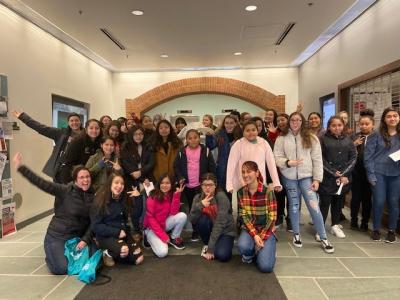In 2018, a group of people concerned about the lack of minority representation among math honors students started a math summer camp for high school female students. The camp’s goal was to create a deeper appreciation of mathematics in an audience who had not developed an interest in mathematics-related careers through traditional instruction.

Two years later, the project has grown to include a wide variety of activities that seek to take mathematics out of the Tower and bring them close to the community. Little by little, Buckeye Aha! Math Moments (BAMM) has become more visible around Columbus. The start of 2020 had a lot of punch, with the calendar full of activities ranging from school visits to a big celebration for the first official International Day of Mathematics.
The event that started it all, the summer camp, is still the backbone of BAMM. Starting in September 2019, the program was enhanced with monthly workshops to keep attendees engaged with math. For the third edition, although it will have to be virtual, the program will expand to include middle school students. The camp has also been opened to people from all genders, though an emphasis still remains on encouraging women and gender nonconforming students to apply.
This year, we also participated for the second time in COSI’s (Center of Science and Industry) Science Festival. In the midst of the COVID pandemic, it was not possible to have an in-person festival, but we joined the museum’s efforts with some virtual activities.

As part of our central mission of reaching out to minorities, we partnered with the Department of African American and African Studies and offered a Math-magic workshop for middle school students at their Community Extension Center, located in Columbus’ Near East Side. We have agreed to host a monthly Math Day exhibit as soon as the center is reopened.
Another important collaboration BAMM has is with Latino and Latin American Studies Space for Enrichment and Research (LASER). Born at the Department of English, LASER is a mentoring system for Latinx high school students to promote success through college. Ohio State students coordinate working groups at the affiliated high schools, where academic and role model activities are hosted. Unfortunately, with schools closed, the visits to the hubs had to be postponed, but we look forward to the day we can be part of this association’s great efforts.

In 2019, we also joined a campus tour for middle school and high school Latina girls organized by Proyecto Mariposas, an organization that supports Latina girls and their mothers, and AWW (Advocates for Women of the World).
On top of that, we keep up with school visits, workshops at public libraries and museums around Ohio, community events, and activities within the Department like volunteer recruitment events. However, there’s still a long way to go. The few women on the Math Honors track still feel out of place, unsupported and daunted. The Hispanic graduate students often feel that way too. We know we have to keep up with the work at different scales, from this Department to the whole state of Ohio, to make mathematics a comfortable place for everybody.
